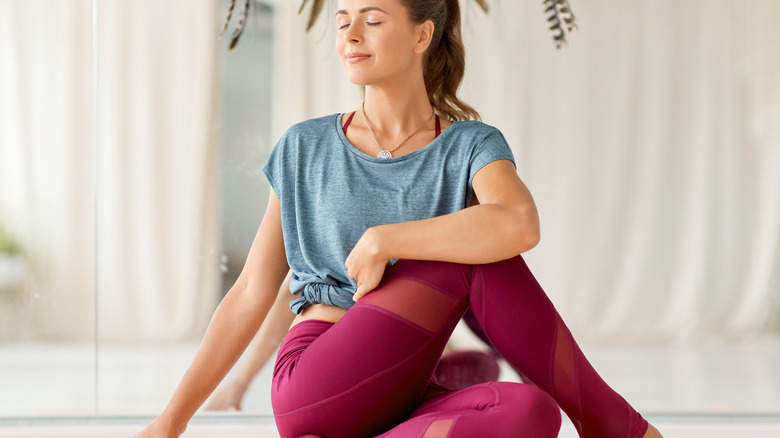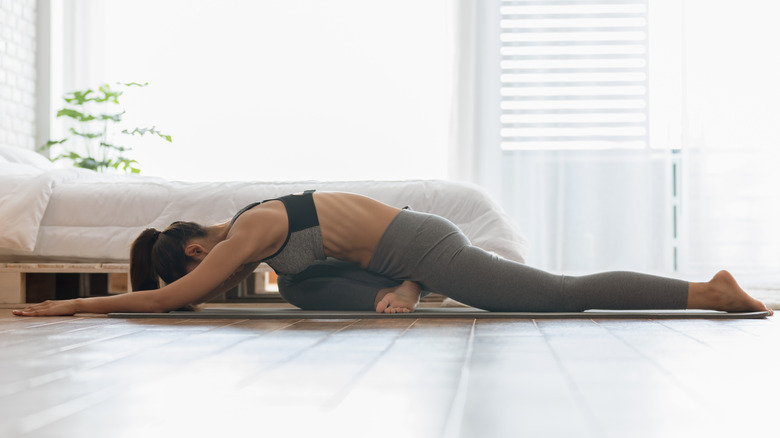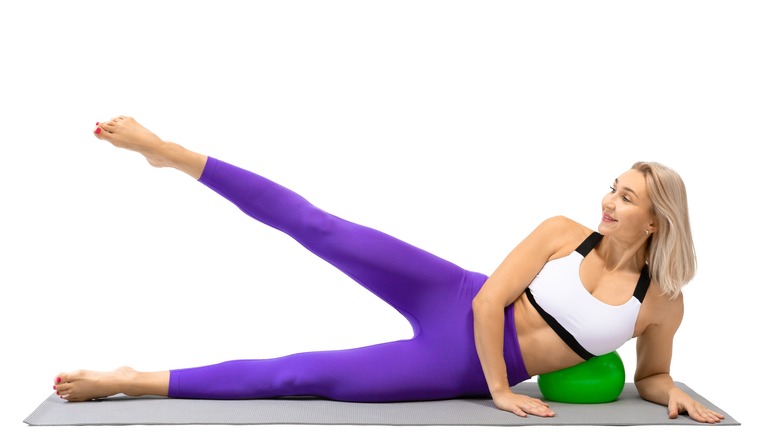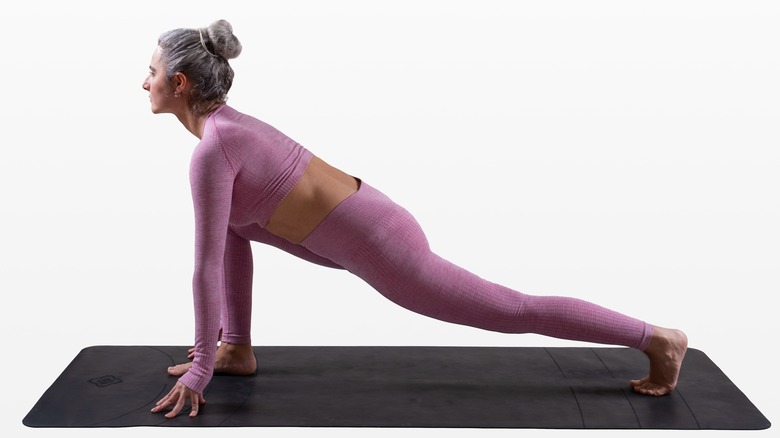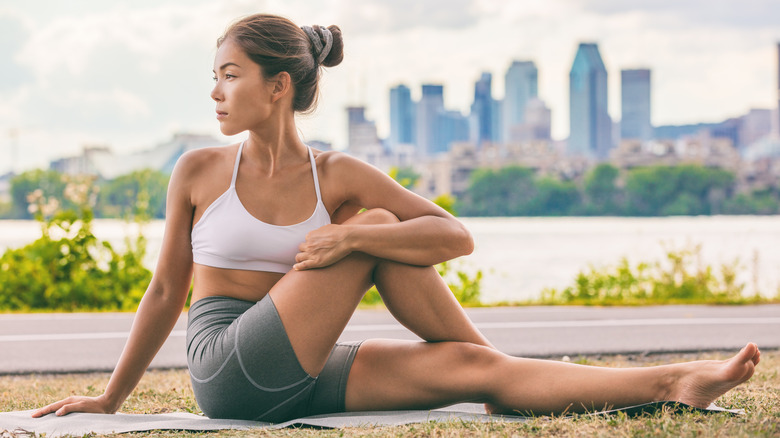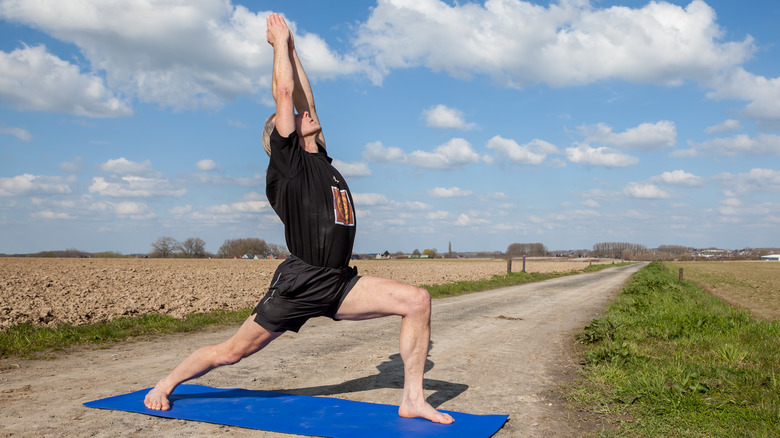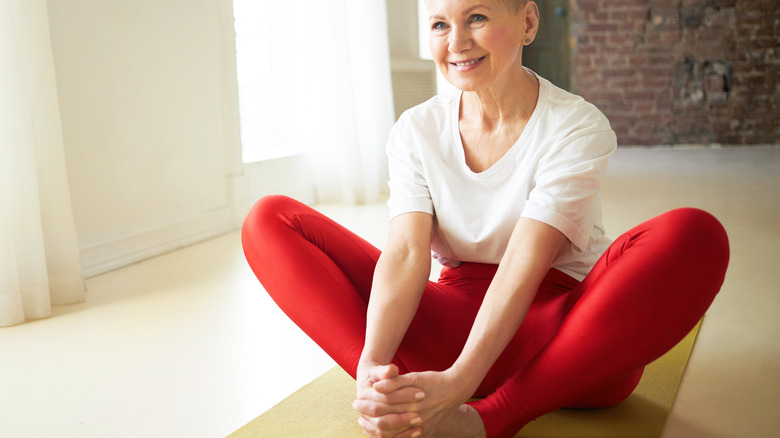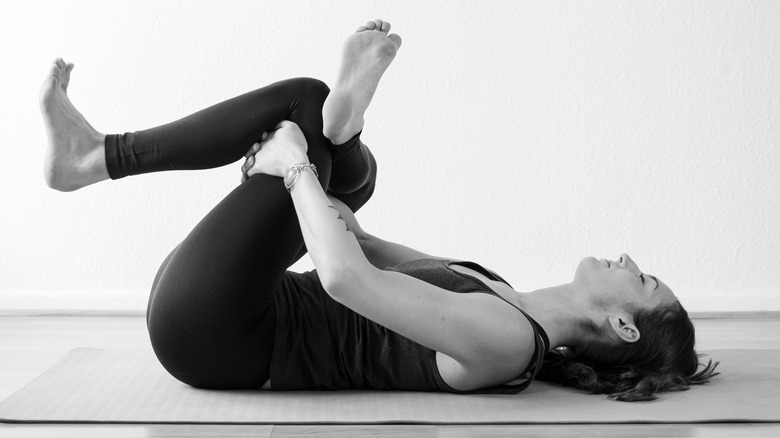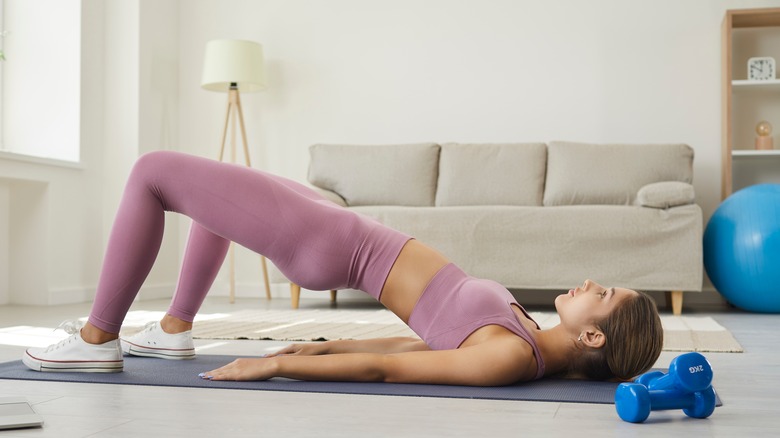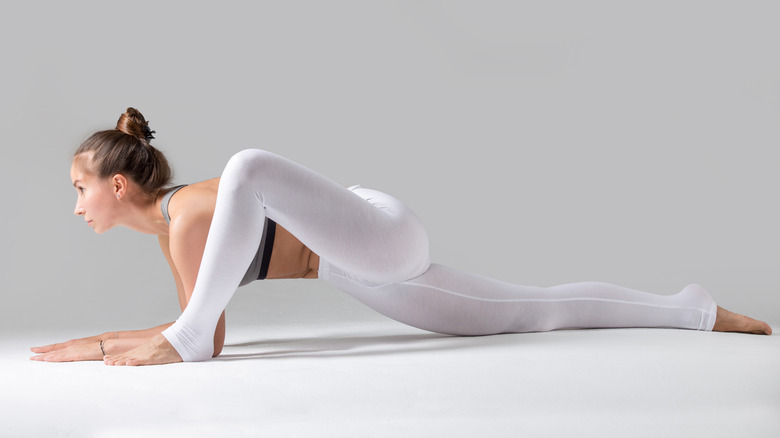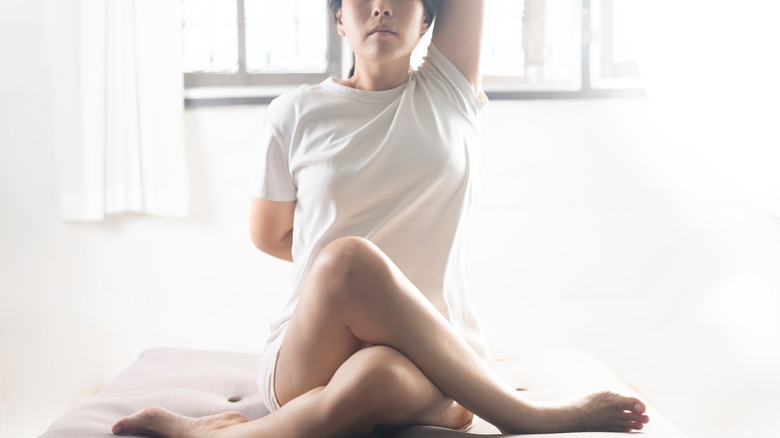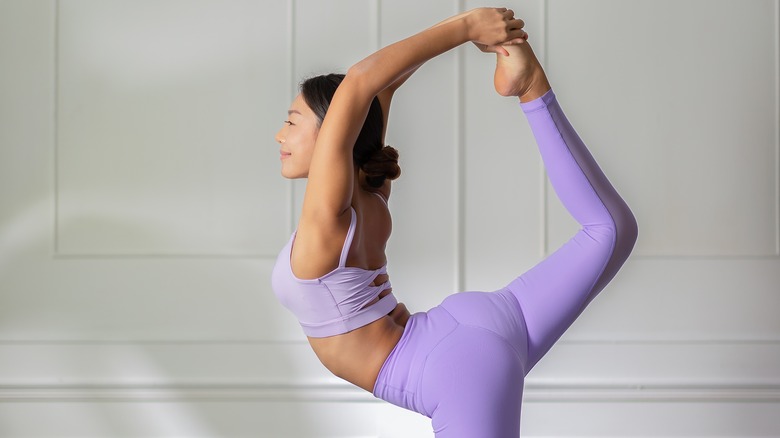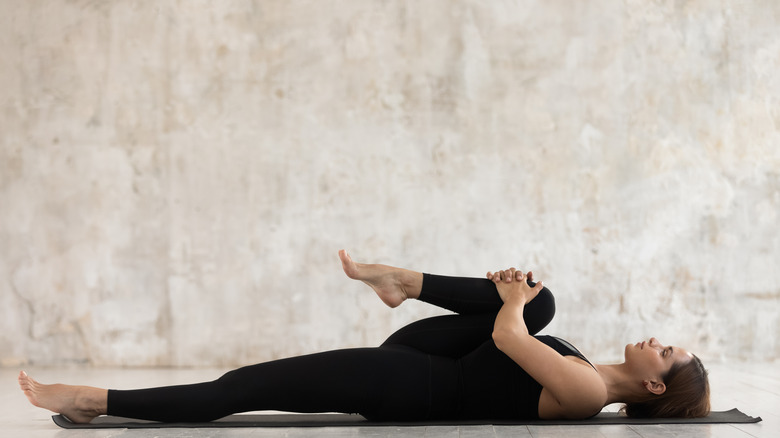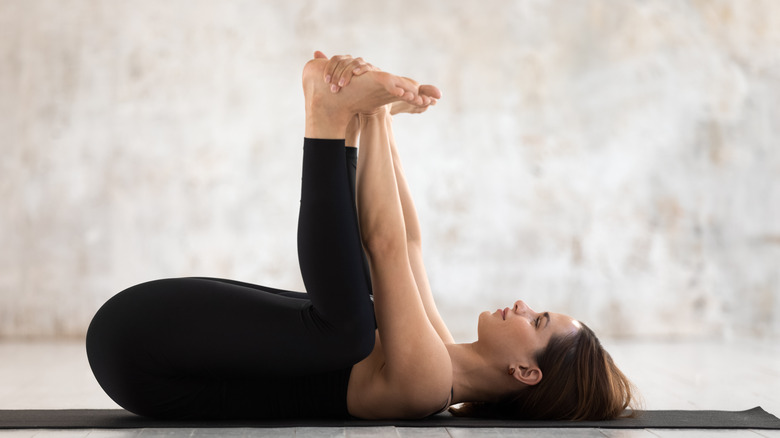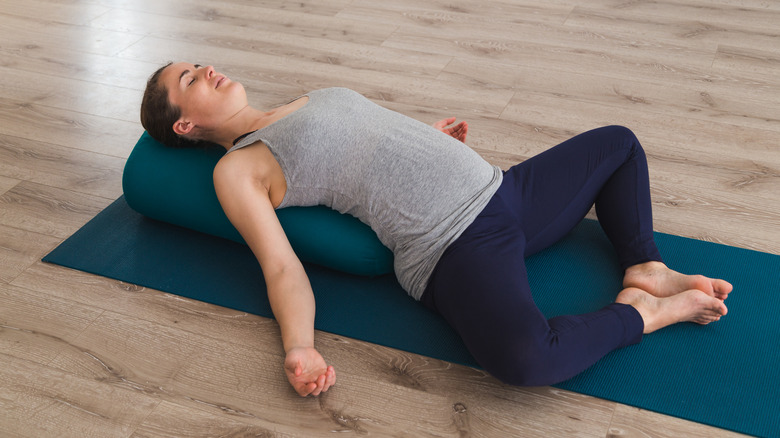13 Hip Stretches To Add To Your Workout Routine
If you feel like your back has gone out, you may have your hips to blame. Tight hip flexors affect your lumbar spine, contributing to your risk of lower back pain, according to a 2021 review in the International Journal of Environmental Research and Public Health. What's more, sedentary behavior contributes to lack in flexibility, particularly in the hips. This affects your strength, balance, and fluidity of movement. Tight hips can also lead to muscle fatigue.
Furthermore, as we get older and flexibility declines, the body is more prone to injury (via Harvard Health Publishing). Thus, a daily stretching routine is beneficial for keeping one in good shape. In addition to the legs, lower back, and torso, your hips are essential for your daily routine. Basic activities for daily living include bending, walking, reaching, shifting, and the transferring of objects (via Family Time Fitness).
So, if you are feeling a bit rusty and stiff in the joints, have no fear. It's never too late to address and improve poor flexibility, according to faculty editor for Harvard Health Publishing's special reports Dr. Lauren Elson (via Harvard Health Publishing). Daily stretching is key, and a complete stretching routine can be done in as little as 5-10 minutes a day, she says. So, give your hips some care by adding hip stretches to your workout routine.
Pigeon pose
Pigeon pose is a great way to stretch your hips and back. It helps with outward hip rotation and lengthening the soas muscle, a primary hip flexor connecting the torso and legs (via Yoga Journal). The more we sit, the more it contracts (and stiffens). There are some variations to suit your needs, including Classic Pigeon and Resting Pigeon (via Healthline). This pose may require a bit of warm up, so consider incorporating some repetitions of down dog and cat-cow before moving into this hip-opening stretch.
For a Classic Pigeon pose, start on your mat on all fours (via Healthline). Press up into downward dog by rooting your hands and feet to the ground and lifting your hips to the ceiling. From this inverted V position, raise your right leg, then draw your right knee to the back of your right wrist. Then, rotate your right shin so it is parallel to the front of your mat. Keep your left leg straight behind you. Gently lower your right butt to the ground, keeping your hips level. As you press your hands into the ground, gently lift your torso to elongate your spine. You can hold it here for a few seconds and repeat on the left side. Or continue to Resting Pigeon by lowering your torso over your right leg and stretching your arms out in front of you, elbows slightly bent. Gently lower your head toward the ground. Hold for 5-10 deep breaths, then repeat on the other side.
Hip circles
Hip circles can improve your stride as well as prevent and alleviate pain (via Chris Boone MD). The circular hip-strengthening motion will also support the muscles and ligaments surrounding the joint — improving overall hip flexibility and lower body strength. One such muscle group that hip circles support is your glutes. Strong glutes help with hip stability and mobility for everyday walking, as well as more strenuous activities like running and heavy lifting (via Self).
To perform this exercise standing, you may need the support of the wall or a chair for balance (via Chris Boone MD). Stand on your left leg and extend your right out so that you can make circles in counterclockwise and clockwise motions. Do 20 circles one way and 20 in the opposite direction. Then, repeat on the other side. You may also perform this exercise lying on your side with both legs extended out, lifting and drawing circles with your top leg (via Canadian Living).
Runner's lunge
Despite what the name might suggest, runner's lunge isn't just for runners. It is an energizing pose that stretches, lengthens, and strengthens the hips, hamstrings, quadriceps, and back (via Tummee). What's more, it's a great exercise for toning the lower body, aligning the spine, and improving overall balance and posture.
Amongst the many benefits of this stretch, it warms up the body for deeper hip-openers (via Yoga15). From a downward facing dog position, step your right foot between your hands. Adjust yourself if needed, so that your right knee is in line with your right ankle (not in front of it). Also, make sure that your toes are facing forward. Widen your stance so that your feet should are hip distance apart. Then, press through your back heel to lengthen your back leg. Hold this pose for 3-5 deep breaths on each side, then repeat it on the other side.
Seated twist
Need to revive yourself after sitting for long hours or feeling worn down from intense activity? The seated twist may give you a little pick-me-up by opening those shoulders and lengthening your spine, improving posture and mobility while providing back pain relief (via Yoga Groove). But more importantly, it's also a great hip-opener, which means it may help prevent the risk of back injury (per the Rochester Athletic Club).
This yoga pose is also known as "Half Lord of the Fishes," and just like any yoga pose, there are variations. Keeping one leg outstretched is one such variation that will aid in stability if that's what you need (via Yoga Journal). Begin seated, cross-legged (a.k.a. the easy pose or Sukhasana), right leg over your left. Sit tall and bring your right foot to the outside of your left knee. If you need more stability, straighten your left leg. Root both hips evenly to the ground. Inhale as you lift your left arm to the ceiling. With your right arm beside your right hip, exhale as you turn your torso to the right. Hook your left elbow outside your right knee as you press into your right hand to get a deeper stretch. Hold for 5 breaths and repeat on the other side.
Crescent lunge
The crescent lunge is a yoga pose that utilizes all the muscles in your body, according to Everyday Yoga. The name is derived from the Sanskrit word "anyenaya," meaning salutation. Hence, it can be well-integrated into a Sun Salutation flow. A dynamic hip flexor stretch, the crescent lunge works the quads, hamstrings, torso, chest, and shoulders. It is a great stretch for toning the hips, thighs, and glutes. What's more, by allowing the front body to expand, it can increase your overall energy.
Start in downward facing dog (via Yoga Journal). From your inverted V position (a.k.a. Adho Mukha Svanasana), step your right foot between your hands. Be sure your knee is aligned over your ankle. Keep your back leg extended and firm. Inhale as you raise your torso upright while circling your arms up overhead. Press through your back heel to help lengthen your spine and reach your fingertips up towards the sky. Tilt your pelvis toward the floor and cinch in your ribcage to avoid over-arching. Hold from 30 seconds to one minute, then repeat on the other side.
Butterfly
Adding the butterfly stretch to your workout routine can be ideal for your loosening tight hips, especially following a hardcore workout or after sitting for extended periods of time (via Healthline). But for those with extremely tight hips, a warm-up is essential (via Yoga Bullet). Before you start this pose, it may be best to incorporate some low lunges. This warm-up will bring circulation into that groin area, as well as a gentle stretch (via Tummee).
Keep it slow and steady as you work your way into the butterfly (via Healthline). Start in a seated position on the floor. Use a prop (i.e., a blanket or small block) below your hips if they are tight. Place the soles of the feet together. Move your feet closer to your hips if you can handle more intensity; or further away if you need more ease. (If your knees are high, you can place cushions below both thighs for better support.) Press into your sit bones and inhale as you elongate your spine. Keeping your spine long, exhale as you move deeper into this hip-opening stretch. Continue to breathe through this pose for up to 2 minutes. Modifications for this pose include pressing your back to a wall for more leverage and approaching the pose from a supine angle (lying on your back) to make it easier.
Thread the needle
Thread the needle, which resembles the number 4, is a great stretch for releasing the hips and glutes (via Oxygen Yoga and Fitness). And although you may not see the connection, this pose is a modified version of pigeon pose (another hip-opener), according to Yogapedia. As this stretch is done in a supine position, it is sometimes called "dead pigeon pose."
Start on the floor, lying on your back (via Oxygen Yoga and Fitness). Bend both knees and place your feet hip distance apart, with your knees right over your ankles. Lift your right foot and place the outside of your ankle over your left thigh to create the shape of the number 4. Draw your left knee to your chest and reach through your legs to grab the back of your left thigh. As you bring your left knee closer, gently resist with your right knee. Hold for 3-5 even breaths. Then, let go of your thigh and release your left foot to the floor. Repeat on the other side.
Bridge pose
When muscles become shorter, tighter, and weaker, posture and mobility are affected (via Yoga International). It all comes down to sedentary behavior. So, get moving and add a bridge pose to your workout routine — it may help assess areas where the hip flexors, glutes, and pelvic muscles have become weak. It will also help lengthen and strengthen these muscles to correct alignment and overall balance.
If you are looking for an exercise to relieve hip pain, this dynamic stretch can relieve the pressure (via Northern Inyo Healthcare District). Start by lying down on your mat. Bend your knees and flatten your feet, keeping them hip distance apart. With your arms by your sides, press into your palms, shoulders, and elbows to help lift your hips while raising your chest toward the ceiling. You can use a block to support your sit bones. (This prop will ease the challenge if your hips are really tight.) Take several breaths, then release your hips back to the mat.
Lizard pose
Lizard pose is a huge hip-opener, and as such, it is best to warm up before starting (via Yoga U Online). Hip circles, (supine) pigeon, and lunges are some good options to do beforehand. Since it is a forward-facing hip-opener, you'll want to keep your feet hip distance apart. Keeping your feet adequately spaced with your (front) toes slightly pointed out can help you stayed properly aligned and create more space within your hip joints, respectively.
Start in a low lunge with your back knee on the floor and shin pressing into the mat (via Self). Walk your front foot out wide to the edge of your mat, placing both hands inside of that foot. Remain here and breathe if this is enough of a stretch for you. Otherwise, place your forearms to the ground for a deeper stretch. Hold for 5 breaths and repeat on the other side.
Cow face pose
Cow face pose, as translated from the Sanskrit "Gomukhasana," loosely resembles that of a cow's face in the completed formation of the pose (via Everyday Yoga). You might imagine a cow's snout and mouth from crossing of the legs, and its ears from the bent positioning of the arms. But what makes this hip opening pose a workout must is that it stretches nearly every part of the body: your hips, arms, legs, shoulders, ankles, and chest.
If your hips are especially tight, use a prop to lift your hips to the height of your knees; two blankets or a yoga block will do. Begin seated with outstretched legs and your arms by your sides. Bend both knees and place your feet flat on the mat. Then, slide your left foot behind your right and move it to the outside of your hip. With your right knee over your left, slide your right foot toward the outside of your left hip. To complete this pose, extend your left arm toward the ceiling (with your palm facing front) and bend at the elbow to touch your spine. Finally, extend your right arm out to the side — rotating externally, so your palm faces behind you — and bend at the elbow to reach the center of your spine.
Dancer's pose
Balance and persistence are what it takes to progress through this pose (via Yoga Journal). But with time, effort, and supportive props (if needed), this hip opening stretch can be achieved. As it requires good posture and balance, it will help strengthen your ankles, too. Start by standing upright with your feet hip distance apart (via Oxygen Yoga and Fitness). Ground your feet into the floor and place your hands on your hips. Shift your weight onto all four corners of your right foot (lift your arch), and allow a slight bend in your right knee. Bend the left leg behind you, drawing the heel toward your left buttocks. Grab your left ankle with your left hand and raise your right arm to the sky. Hinge at the hips to lean forward as you firmly press your left ankle into your left hand for resistance. Align your hips, square off your shoulders, and engage your leg and core muscles. Breathe deeply to hold this pose for as long as it is comfortable. Then, gently bring your knees together and release your left foot. Shake it out and repeat on the other side.
Knee to chest
Hip flexors are a group of muscles responsible for bringing the leg up toward the torso (via Healthline). Collectively called the iliopsoas, the soas and iliacus muscles work together to stabilize the trunk for activities such as walking, lifting, pushing, and pulling. As such, a single knee to chest stretch is beneficial for activities we perform daily. When done regularly, this stretch can improve stability and maximize your mobility (via Physiopedia).
Start by lying on your back with both legs extended. Keep your lower back flat and your hips level, or bend your knees toward the ceiling and place your feet flat on the floor (via Chiropractic Professionals of Columbia). Hug your right knee towards your chest, using both hands guide it forward. Breathe through this stretch for about 10-30 seconds. Then, gently release it to resting position. Do 10 repetitions, then repeat it on the other side. You may follow this up by bringing both knees to your chest.
Happy baby
Happy baby is a hip-opening stretch that targets your inner thighs (your hip abductors) and the groin (via Body by Yoga). It also may help relieve tight hamstrings. Additionally, this pose is great for relieving stress, as it is as relaxing as it is lengthening.
Start by lying down with both knees bent and feet flat on the floor (via Self). Raise your feet from the floor and reach for the outside edges of your feet. Gently pull your feet toward your chest and allow your knees to splay to opposite sides of the body. Keeping your back flat on the floor, hold this pose for 5 breaths or more. To get the most benefit from this stretch, it is important to keep your shoulders grounded, flatten the back of your neck (with chin slightly tucked), relax your hips, and ease into the stretch instead of forcing it (via Body By Yoga).
Exercising with hip issues
While performing hip exercises may lead to some discomfort, they should not result in — or worsen — pain (via Medical News Today). If you have undergone hip surgery, it is important to consult your physician or physical therapist before starting any hip exercises. That being said, hip exercises are beneficial because they can help improve joint mobility and reduce stiffness.
Limit your stretching to just one or two exercises per day, 3 times per week (via Medical News Today). Work your way up as your comfort improves over time. It is best to start when muscles are most relaxed; a warm shower or bath may help. Or schedule 5-10 minutes of light activity first to warm your muscles and joints (via Pelvic Exercises Physiotherapy). Pay attention to your body, and keep the holding time and number of repetitions suitable for your needs; 15-30 second holds with 2-3 repetitions may be ideal. If tight hips limit your flexibility, you may use props such as a yoga block, blanket, or bolster to add support where needed (via Pain Doctor). You may also benefit from modifications, including approaching a pose from a supine (lying down) position (via Healthline).

